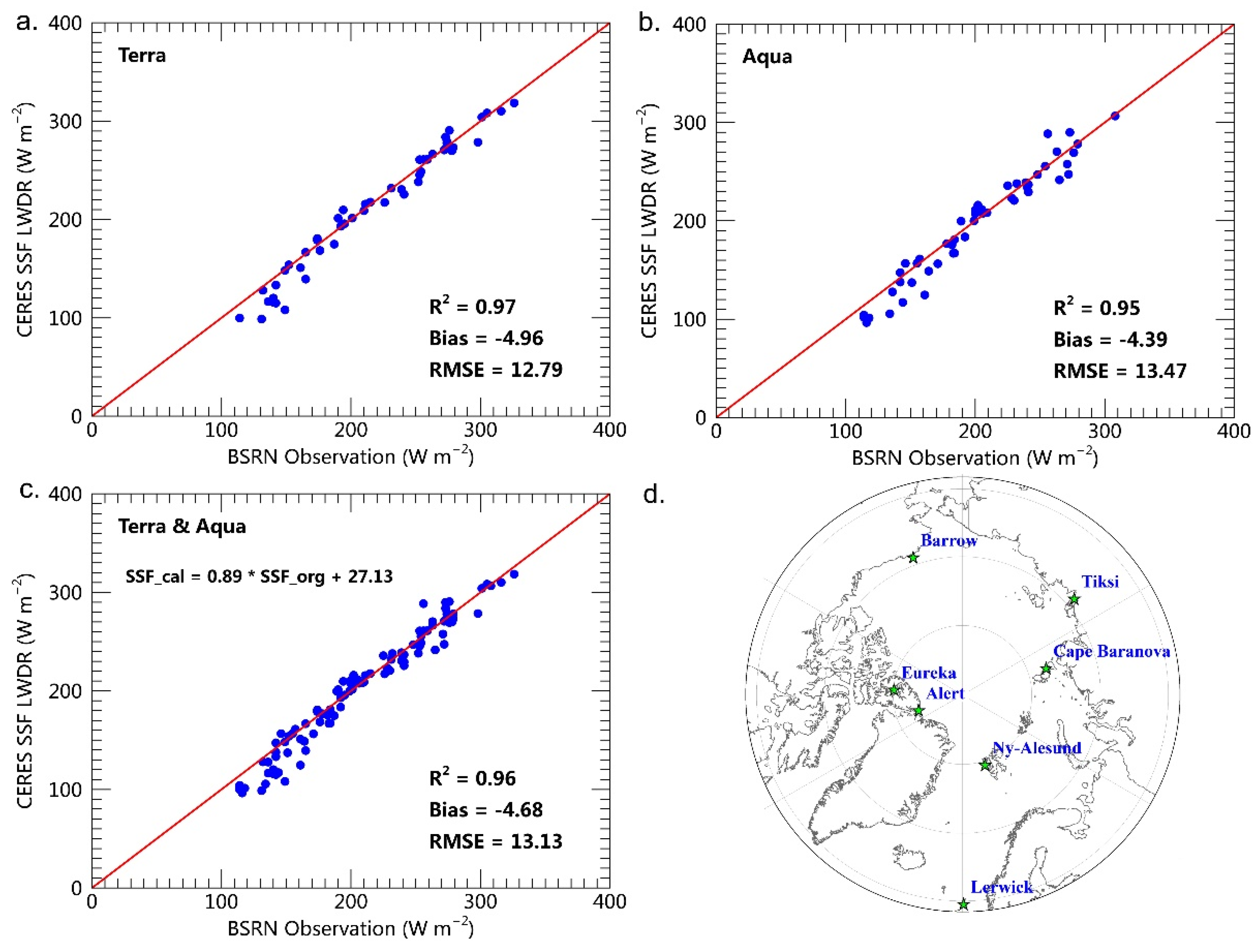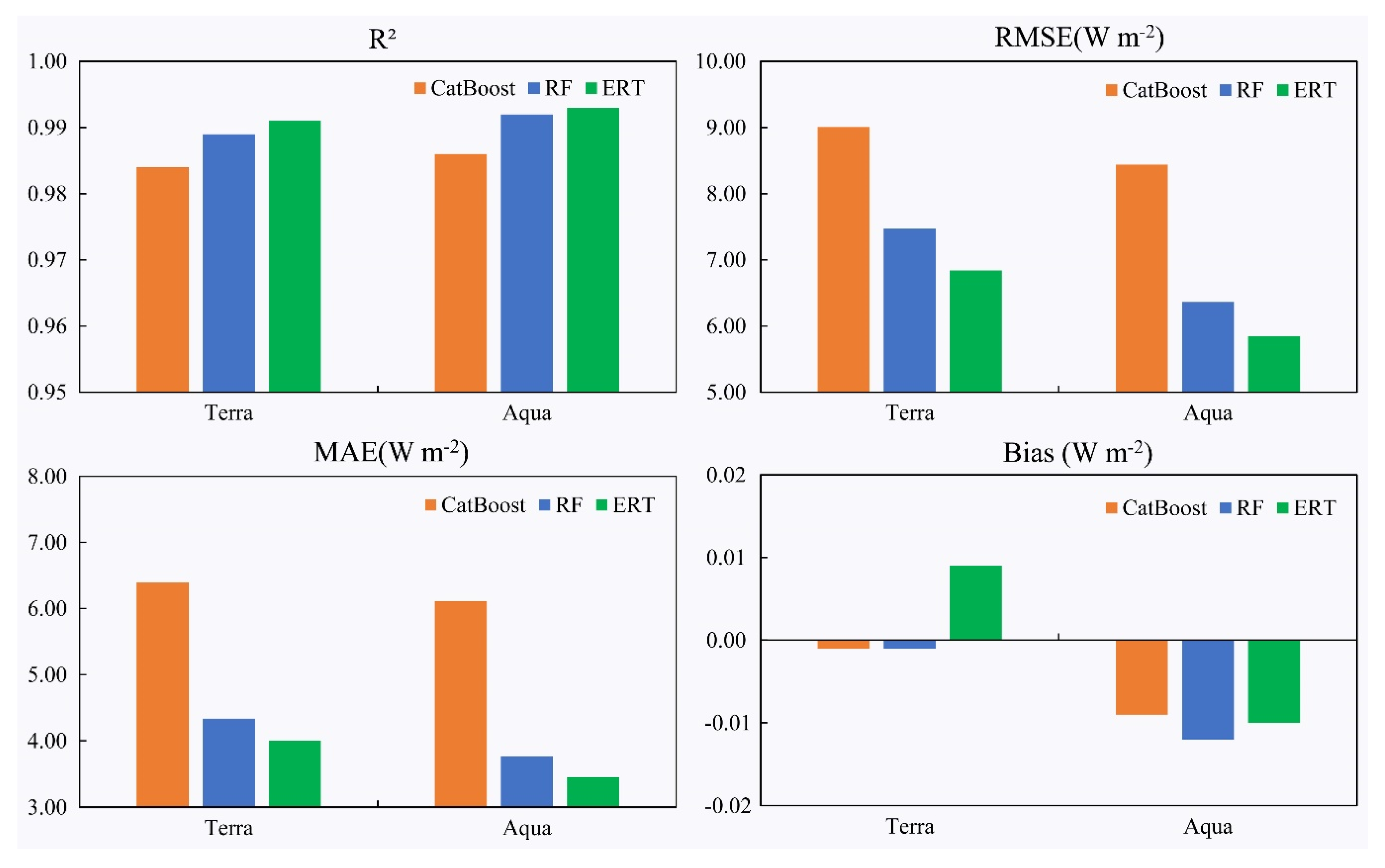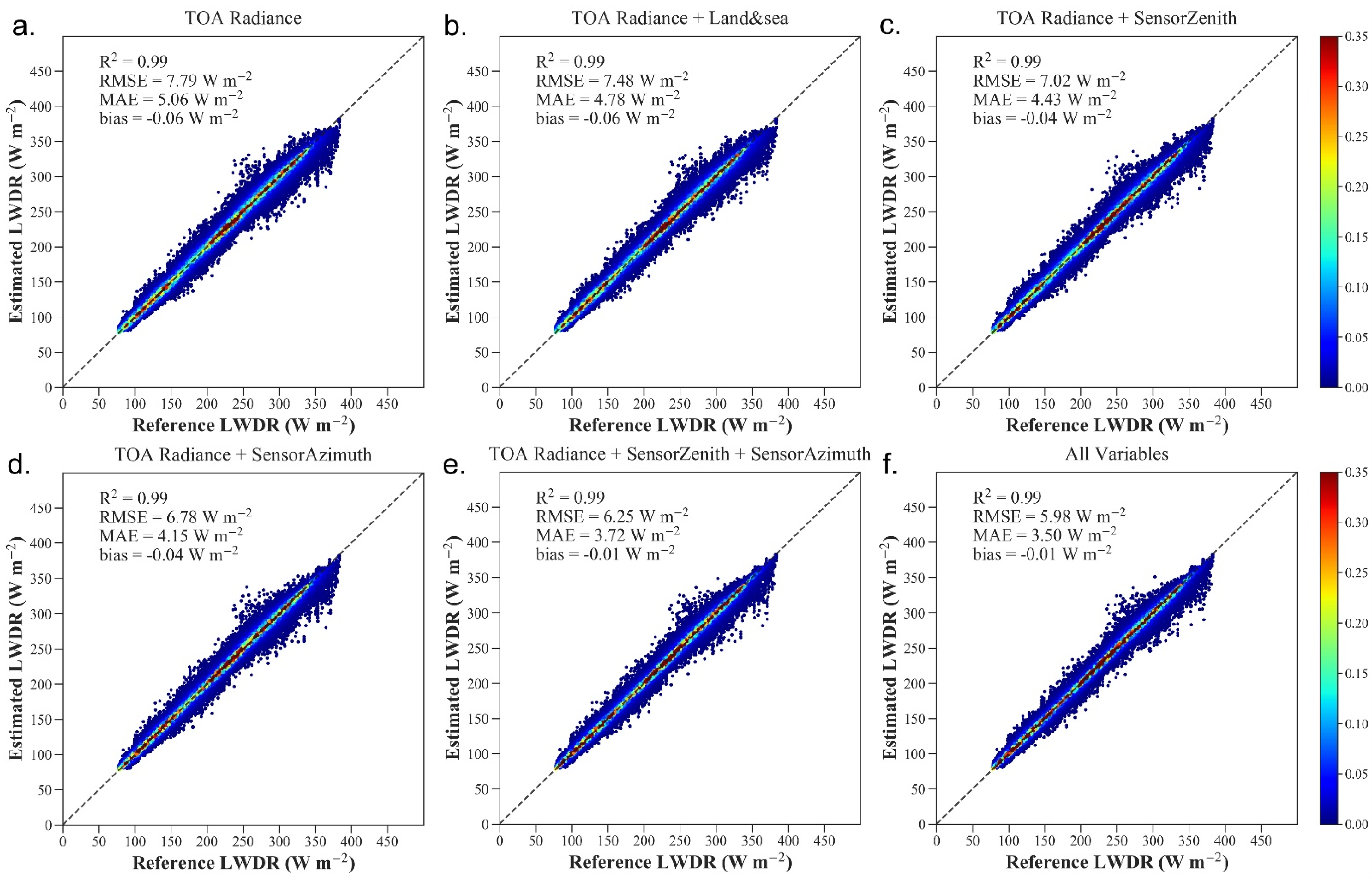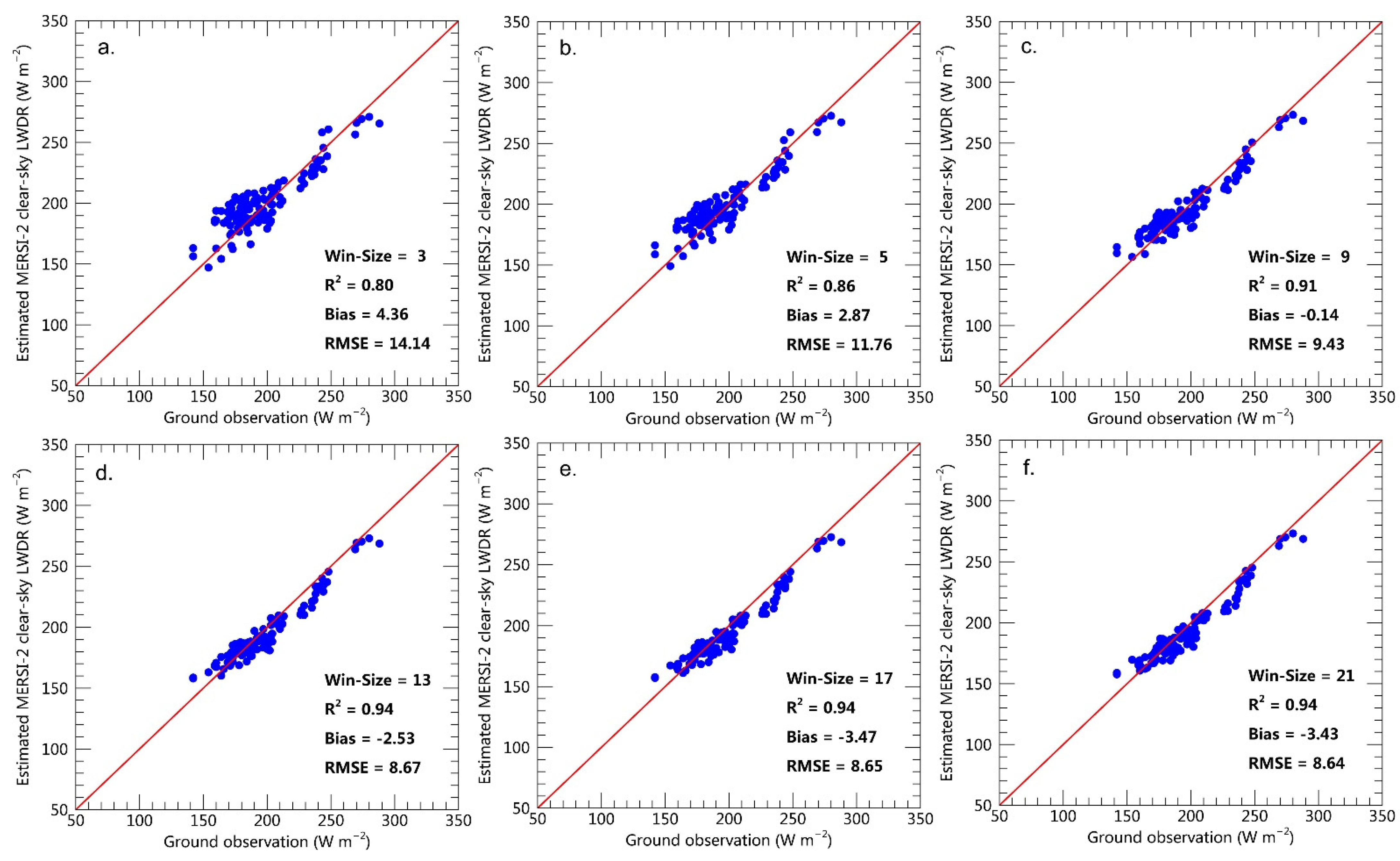Estimating the Clear-Sky Longwave Downward Radiation in the Arctic from FengYun-3D MERSI-2 Data
Abstract
:1. Introduction
2. Materials and Methods
2.1. Data
2.1.1. FY-3D MERSI-2 Data
2.1.2. CERES Single Scanner Footprint (SSF) Product
2.1.3. BSRN In Situ Measurements
2.2. Method
2.2.1. Training Database Generation
2.2.2. Machine Learning Algorithms for Clear-Sky LWDR Estimation
2.2.3. Accuracy Assessment
3. Results
3.1. CERES SSF Calibrationion
3.2. Comparison of ML Algorithms
3.3. Sensitivity Analysis of Model Inputs
3.4. Validation of the Clear-Sky LWDR Retrievals
4. Discussion
5. Conclusions
Author Contributions
Funding
Acknowledgments
Conflicts of Interest
References
- Trenberth, K.E.; Fasullo, J.T.; Kiehl, J.T. Earth’s global energy budget. Bull. Am. Meteorol. Soc. 2009, 90, 311–324. [Google Scholar] [CrossRef]
- Burt, M.A.; Randall, D.A.; Branson, M.D. Dark Warming. J. Clim. 2015, 29, 705–719. [Google Scholar] [CrossRef]
- Cao, Y.; Liang, S.; Chen, X.; He, T.; Wang, D.; Cheng, X. Enhanced wintertime greenhouse effect reinforcing Arctic amplification and initial sea-ice melting. Sci. Rep. 2017, 7, 8462. [Google Scholar] [CrossRef] [PubMed] [Green Version]
- Park, H.-S.; Lee, S.; Kosaka, Y.; Son, S.-W.; Kim, S.-W. The Impact of Arctic Winter Infrared Radiation on Early Summer Sea Ice. J. Clim. 2015, 28, 6281–6296. [Google Scholar] [CrossRef]
- Bintanja, R.; Graversen, R.G.; Hazeleger, W. Arctic winter warming amplified by the thermal inversion and consequent low infrared cooling to space. Nat. Geosci. 2011, 4, 758–761. [Google Scholar] [CrossRef]
- Pithan, F.; Mauritsen, T. Arctic amplification dominated by temperature feedbacks in contemporary cliamte models. Nat. Geosci. 2014, 7, 181–184. [Google Scholar] [CrossRef]
- Kapsch, M.-L.; Graversen, R.G.; Tjernström, M. Springtime atmospheric energy transport and the control of Arctic summer sea-ice extent. Nat. Clim. Chang. 2013, 3, 744–748. [Google Scholar] [CrossRef]
- Liang, S.; Wang, D.; He, T.; Yu, Y. Remote sensing of earth’s energy budget: Synthesis and review. Int. J. Digit. Earth 2019, 12, 737–780. [Google Scholar] [CrossRef] [Green Version]
- Ma, Q.; Wang, K.; Wild, M. Evaluations of atmospheric downward longwave radiation from 44 coupled general circulation models of CMIP5. J. Geophys. Res. Atmos. 2014, 119, 4486–4497. [Google Scholar] [CrossRef]
- Wang, K.; Dickinson, R.E. Global atmospheric downward longwave radiation at the surface from ground-based observations, satellite retrievals, and reanalyses. Rev. Geophys. 2013, 51, 150–185. [Google Scholar] [CrossRef]
- Cheng, J.; Liang, S.; Wang, W.; Guo, Y. An efficient hybrid method for estimating clear—Sky surface downward longwave radiation from MODIS data. J. Geophys. Res. Atmos. 2016, 122, 2616–2630. [Google Scholar] [CrossRef]
- Zhou, W.; Shi, J.C.; Wang, T.X.; Peng, B.; Husi, L.; Yu, Y.C.; Zhao, R. New Methods for Deriving Clear-Sky Surface Longwave Downward Radiation Based on Remotely Sensed Data and Ground Measurements. Earth Space Sci. 2019, 6, 2071–2086. [Google Scholar] [CrossRef] [Green Version]
- Wang, T.; Yan, G.; Chen, L. Consistent retrieval methods to estimate land surface shortwave and longwave radiative flux components under clear-sky conditions. Remote Sens. Environ. 2012, 124, 61–71. [Google Scholar] [CrossRef]
- Wang, T.; Shi, J.; Ma, Y.; Letu, H.; Li, X. All-sky longwave downward radiation from satellite measurements: General parameterizations based on LST, column water vapor and cloud top temperature. ISPRS J. Photogramm. Remote Sens. 2020, 161, 52–60. [Google Scholar] [CrossRef]
- Carmona, F.; Rivas, R.; Caselles, V. Estimation of daytime downward longwave radiation under clear and cloudy skies conditions over a sub-humid region. Theor. Appl. Climatol. 2013, 115, 281–295. [Google Scholar] [CrossRef]
- Wang, W.; Liang, S. Estimation of high-spatial resolution clear-sky longwave downward and net radiation over land surfaces from MODIS data. Remote Sens. Environ. 2009, 113, 745–754. [Google Scholar] [CrossRef]
- Wang, W.; Liang, S. A Method for Estimating Clear-Sky Instantaneous Land-Surface Longwave Radiation With GOES Sounder and GOES-R ABI Data. IEEE Geosci. Remote Sens. Lett. 2010, 7, 708–712. [Google Scholar] [CrossRef]
- Cheng, J.; Liang, S.; Wang, W. Surface Downward Longwave Radiation. Compr. Remote Sens. 2018, 5, 196–216. [Google Scholar]
- Feng, C.; Zhang, X.; Wei, Y.; Zhang, W.; Hou, N.; Xu, J.; Jia, K.; Yao, Y.; Xie, X.; Jiang, B.; et al. Estimating Surface Downward Longwave Radiation Using Machine Learning Methods. Atmosphere 2020, 11, 1147. [Google Scholar] [CrossRef]
- Yang, F.; Cheng, J. A framework for estimating cloudy sky surface downward longwave radiation from the derived active and passive cloud property parameters. Remote Sens. Environ. 2020, 248, 111972. [Google Scholar] [CrossRef]
- Zhou, W.; Shi, J.; Wang, T.; Peng, B.; Zhao, R.; Yu, Y. Clear-Sky Longwave Downward Radiation Estimation by Integrating MODIS Data and Ground-Based Measurements. IEEE J. Sel. Top. Appl. Earth Obs. Remote Sens. 2019, 12, 450–459. [Google Scholar] [CrossRef]
- Tang, K.; Zhu, H.; Ni, P.; Li, R.; Fan, C. Retrieving Land Surface Temperature From Chinese FY-3D MERSI-2 Data Using an Operational Split Window Algorithm. IEEE J. Sel. Top. Appl. Earth Obs. Remote Sens. 2021, 14, 6639–6651. [Google Scholar] [CrossRef]
- Belgiu, M.; Drăguţ, L. Random forest in remote sensing: A review of applications and future directions. ISPRS J. Photogramm. Remote Sens. 2016, 114, 24–31. [Google Scholar] [CrossRef]
- Carter, C.; Liang, S. Evaluation of ten machine learning methods for estimating terrestrial evapotranspiration from remote sensing. Int. J. Appl. Earth Obs. Geoinf. 2019, 78, 86–92. [Google Scholar] [CrossRef]
- Wang, L.; Zhang, Y.; Yao, Y.; Xiao, Z.; Shang, K.; Guo, X.; Yang, J.; Xue, S.; Wang, J. GBRT-Based Estimation of Terrestrial Latent Heat Flux in the Haihe River Basin from Satellite and Reanalysis Datasets. Remote Sens. 2021, 13, 1054. [Google Scholar] [CrossRef]
- Zhang, Y.; Ma, J.; Liang, S.; Li, X.; Li, M. An Evaluation of Eight Machine Learning Regression Algorithms for Forest Aboveground Biomass Estimation from Multiple Satellite Data Products. Remote Sens. 2020, 12, 4015. [Google Scholar] [CrossRef]
- Kratz, D.P.; Gupta, S.K.; Wilber, A.C.; Sothcott, V.E. Validation of the CERES Edition 2B Surface-Only Flux Algorithms. J. Appl. Meteorol. Climatol. 2010, 49, 164–180. [Google Scholar] [CrossRef]
- Luo, M.; Wang, Y.; Xie, Y.; Zhou, L.; Qiao, J.; Qiu, S.; Sun, Y. Combination of Feature Selection and CatBoost for Prediction: The First Application to the Estimation of Aboveground Biomass. Forests 2021, 12, 216. [Google Scholar] [CrossRef]
- Azpiroz, I.; Oses, N.; Quartulli, M.; Olaizola, I.G.; Guidotti, D.; Marchi, S. Comparison of Climate Reanalysis and Remote-Sensing Data for Predicting Olive Phenology through Machine-Learning Methods. Remote Sens. 2021, 13, 1224. [Google Scholar] [CrossRef]
- Kratz, D.P.; Gupta, S.K.; Wilber, A.C.; Sothcott, V.E. Validation of the CERES Edition-4A Surface-Only Flux Algorithms. J. Appl. Meteorol. Climatol. 2020, 59, 281–295. [Google Scholar] [CrossRef]
- Ohmura, A.; Dutton, E.G.; Forgan, B.; Fröhlich, C.; Gilgen, H.; Hegner, H.; Heimo, A.; König-Langlo, G.; McArthur, B.; Müller, G.; et al. Baseline Surface Radiation Network (BSRN_WCRP): New Precision Radiometry for Climate Research. Bull. Am. Meteorol. Soc. 1998, 79, 2115–2136. [Google Scholar] [CrossRef] [Green Version]
- Geurts, P.; Ernst, D.; Wehenkel, L. Extremely randomized trees. Mach. Learn. 2006, 63, 3–42. [Google Scholar] [CrossRef] [Green Version]
- Liang, S.; Wang, K.; Zhang, X.; Wild, M. Review on Estimation of Land Surface Radiation and Energy Budgets From Ground Measurement, Remote Sensing and Model Simulations. IEEE J. Sel. Top. Appl. Earth Obs. Remote Sens. 2010, 3, 225–240. [Google Scholar] [CrossRef]





| MERSI-2 | MODIS | ||||
|---|---|---|---|---|---|
| Band No. | Central Wavelength (μm) | Primary Purpose | Band No. | Central Wavelength (μm) | Primary Purpose |
| 20 | 3.80 | surface, cloud temperature | 20 | 3.75 | surface, cloud temperature |
| 21 | 4.05 | 23 | 4.05 | ||
| 22 | 7.20 | atmospheric water vapor | 28 | 7.325 | atmospheric water vapor |
| 23 | 8.55 | 29 | 8.55 | ||
| 24 | 10.80 | surface temperature | 31 | 11.03 | surface temperature |
| 25 | 12.0 | 32 | 12.02 | ||
| Site Name | Lable | Elevation (m) | Time Coverage | Land Cover |
|---|---|---|---|---|
| Alert | ALE | 127 | August 2004–June 2014 | tundra |
| Barrow | BAR | 8 | January 1992–August 2017 | grass |
| Cape Baranova | CAP | -/- | January 2016–December 2016 | tundra |
| Eureka | EUR | 85 | September 2007–December 2011 | tundra |
| Lerwick | LER | 80 | January 2001–July 2017 | grass |
| Ny-Alesund | NYA | 11 | July 1992–Current | tundra |
| Tiksi | TIK | 48 | June 2010–March 2018 | tundra |
| ML Model | Terra | Aqua | ||||||
|---|---|---|---|---|---|---|---|---|
| R2 | RMSE | MAE | Bias | R2 | RMSE | MAE | Bias | |
| RF | 0.99 | 7.48 | 4.34 | −0.001 | 0.99 | 6.36 | 3.78 | −0.012 |
| ERT | 0.99 | 6.84 | 4.00 | 0.009 | 0.99 | 5.85 | 3.45 | −0.010 |
| CatBoost | 0.98 | 9.01 | 6.40 | −0.001 | 0.99 | 8.44 | 6.11 | −0.009 |
| Model Inputs | Terra | Aqua | ||||||
|---|---|---|---|---|---|---|---|---|
| R2 | RMSE | MAE | Bias | R2 | RMSE | MAE | Bias | |
| TOA radiance | 0.98 | 8.85 | 5.67 | −0.05 | 0.99 | 7.47 | 4.88 | −0.03 |
| TOA radiance, Land&sea | 0.99 | 8.63 | 5.49 | −0.03 | 0.99 | 7.14 | 4.59 | −0.05 |
| TOA radiance, SZA | 0.99 | 7.86 | 4.86 | −0.03 | 0.99 | 6.82 | 4.32 | −0.01 |
| TOA radiance, SAA | 0.99 | 7.86 | 4.77 | −0.04 | 0.99 | 6.57 | 4.05 | −0.02 |
| TOA radiance, SZA, SAA | 0.99 | 7.07 | 4.17 | −0.03 | 0.99 | 6.13 | 3.68 | 0.01 |
| All | 0.99 | 6.84 | 4.00 | −0.01 | 0.99 | 5.85 | 3.45 | −0.01 |
| Window Size (N × N km) | ||||||||||
|---|---|---|---|---|---|---|---|---|---|---|
| 3 | 5 | 7 | 9 | 11 | 13 | 15 | 17 | 19 | 21 | |
| R2 | 0.80 | 0.86 | 0.89 | 0.91 | 0.93 | 0.94 | 0.94 | 0.94 | 0.94 | 0.94 |
| RMSE | 14.14 | 11.76 | 10.39 | 9.43 | 8.87 | 8.67 | 8.62 | 8.65 | 8.65 | 8.64 |
| Bias | 4.36 | 2.87 | 1.34 | −0.14 | −1.49 | −2.53 | −3.17 | −3.47 | −3.48 | −3.43 |
Publisher’s Note: MDPI stays neutral with regard to jurisdictional claims in published maps and institutional affiliations. |
© 2022 by the authors. Licensee MDPI, Basel, Switzerland. This article is an open access article distributed under the terms and conditions of the Creative Commons Attribution (CC BY) license (https://creativecommons.org/licenses/by/4.0/).
Share and Cite
Cao, Y.; Li, M.; Zhang, Y. Estimating the Clear-Sky Longwave Downward Radiation in the Arctic from FengYun-3D MERSI-2 Data. Remote Sens. 2022, 14, 606. https://doi.org/10.3390/rs14030606
Cao Y, Li M, Zhang Y. Estimating the Clear-Sky Longwave Downward Radiation in the Arctic from FengYun-3D MERSI-2 Data. Remote Sensing. 2022; 14(3):606. https://doi.org/10.3390/rs14030606
Chicago/Turabian StyleCao, Yunfeng, Manyao Li, and Yuzhen Zhang. 2022. "Estimating the Clear-Sky Longwave Downward Radiation in the Arctic from FengYun-3D MERSI-2 Data" Remote Sensing 14, no. 3: 606. https://doi.org/10.3390/rs14030606
APA StyleCao, Y., Li, M., & Zhang, Y. (2022). Estimating the Clear-Sky Longwave Downward Radiation in the Arctic from FengYun-3D MERSI-2 Data. Remote Sensing, 14(3), 606. https://doi.org/10.3390/rs14030606





